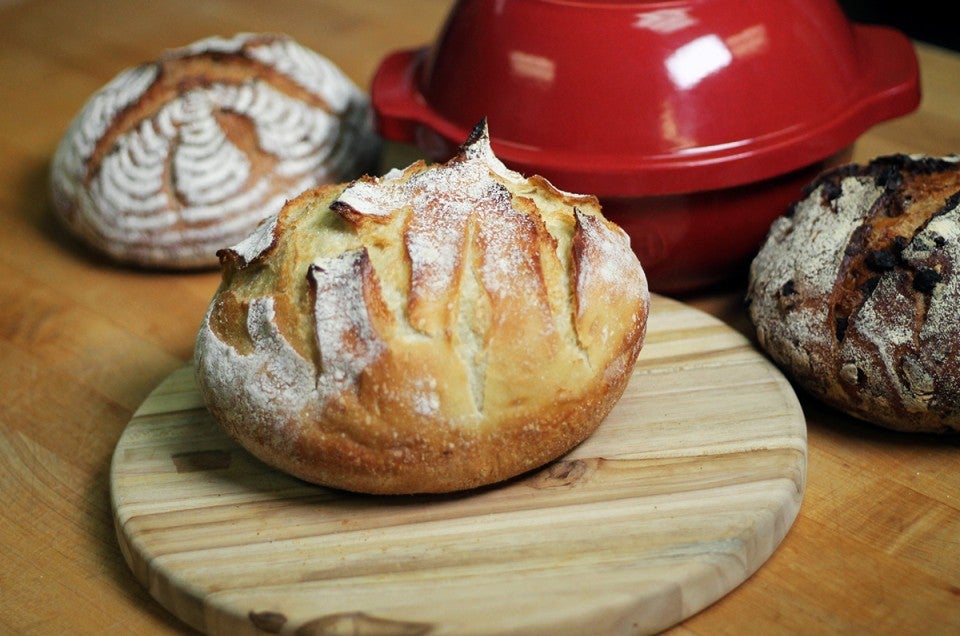


Making crispy, crusty, golden loaves of bread at home has never been easier. It all starts with bread baking in a Dutch oven (lidded pot), the perfect vessel for making artisan-style loaves. The steam that's created inside the pot miraculously transforms the dough, ensuring the bread's crust will shatter into delicate shards with each bite. The best way to produce steam inside a lidded pot? It's simple: preheat the pot.
Gently slipping risen yeast dough into a searing hot pot and adding the lid creates steam. In turn, this results in bread with a crackly crust and a glossy surface that's beautifully blistered with bubbles.
We’re no strangers to baking with steam, but our excitement about this classic method has been rekindled. The arrival of Emile Henry’s Bread and Potato Pot, a unique Dutch oven, has us eager to bake!
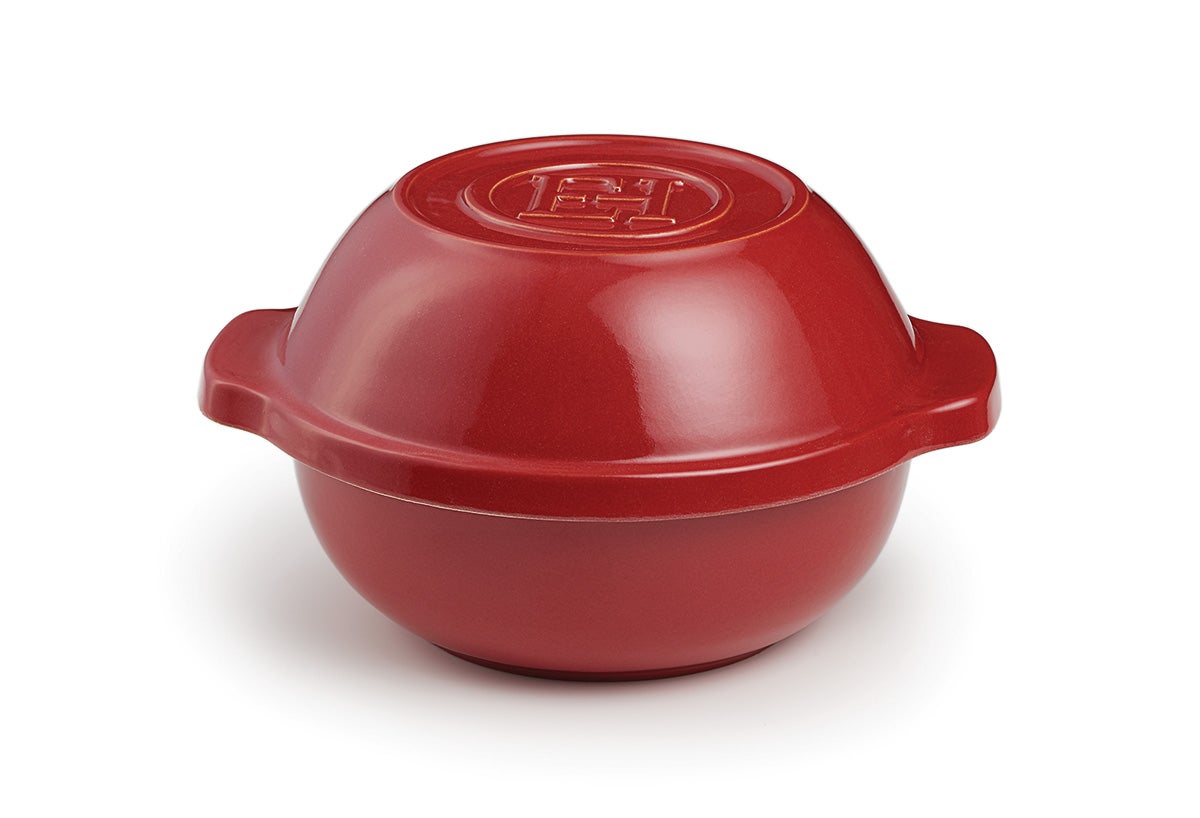 While this pot is often used in France to make perfectly cooked potatoes, it’s also a game-changer when it comes to bread baking in a Dutch oven. Some bread crocks can't withstand the intensity of being heated empty and are bound to crack when nothing's inside. However, this pot is part of Emile Henry's flame line, which is known for its durability and high-heat resistance.
While this pot is often used in France to make perfectly cooked potatoes, it’s also a game-changer when it comes to bread baking in a Dutch oven. Some bread crocks can't withstand the intensity of being heated empty and are bound to crack when nothing's inside. However, this pot is part of Emile Henry's flame line, which is known for its durability and high-heat resistance.
You'll see why we love bread baking in Dutch oven like this — the loaves that come out of it are just as beautiful as they are delicious.
When the Bread and Potato Pot is preheated empty, it becomes a miniaturized version of a professional steam-injected oven. The heat is distributed more evenly than in a conventional oven, and the steam transforms the dough in a few magical ways.
When unbaked dough, with all its interior moisture, is put inside the hot pot, precious humidity is captured in the form of steam. The steam keeps the crust soft longer, so it can continue to expand during the early stages of baking. The result is a lofty loaf that looks like it came from the bakery down the street!
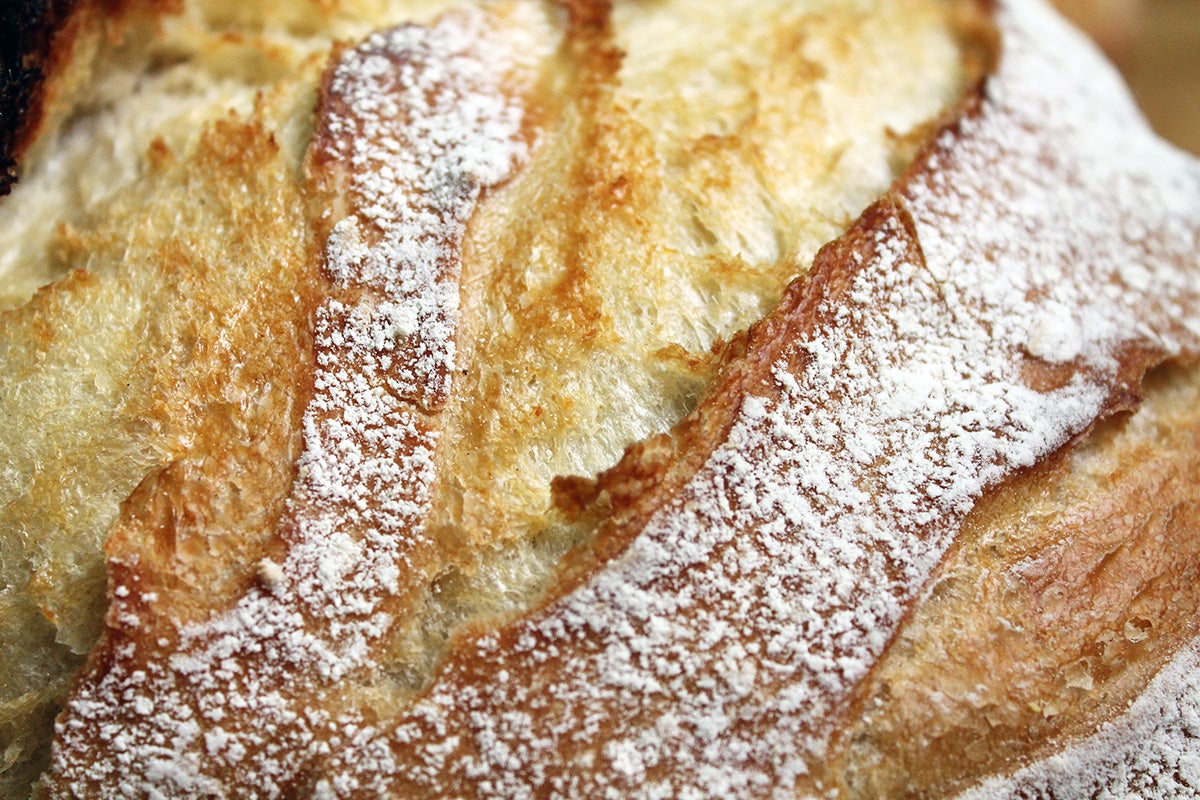
In addition, the steam hitting the bread's surface gelatinizes some of the starches there, which swell and become glossy, creating a crust with subtle, attractive luster.
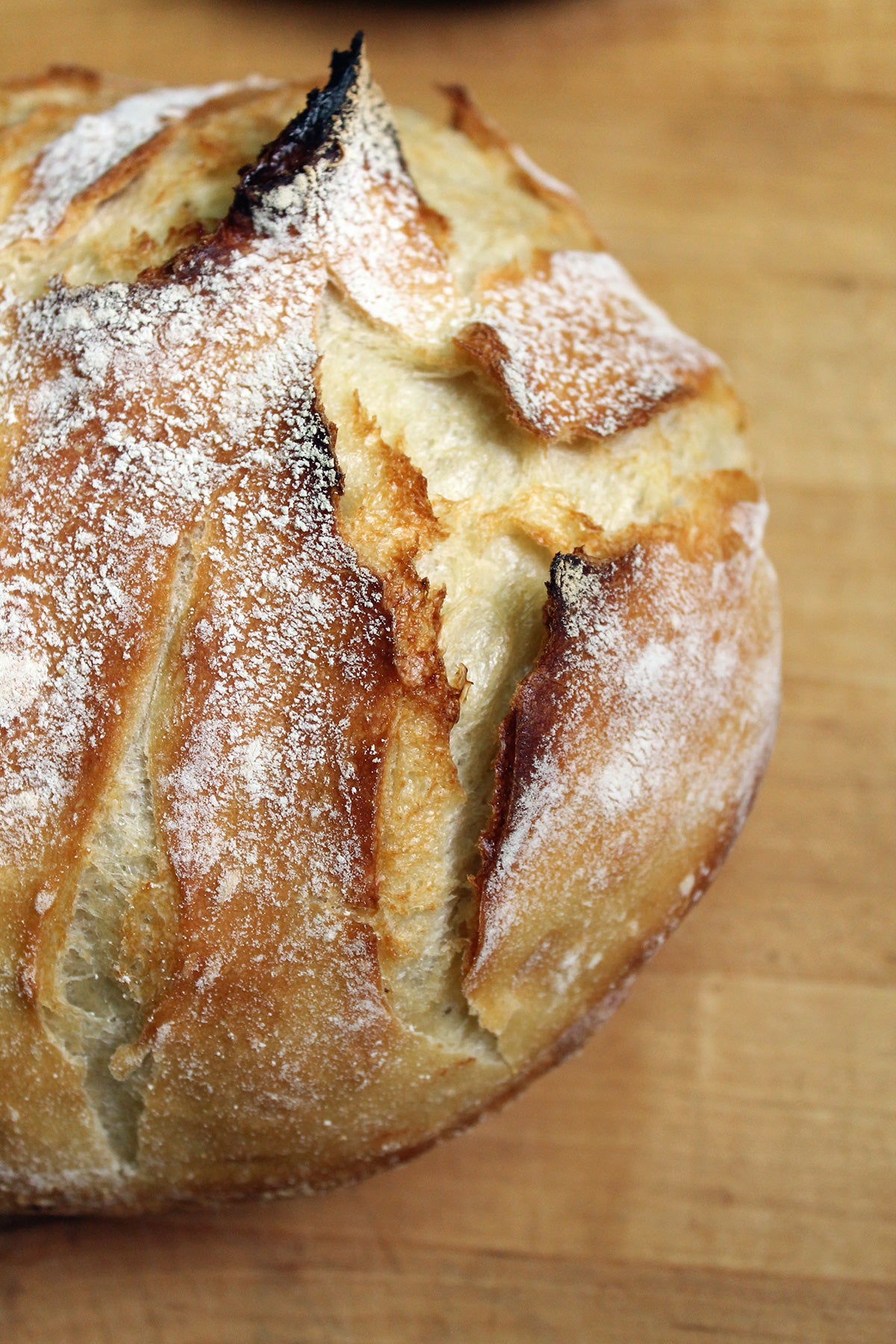
Also thanks to steam, any slashes or “scores” made in the risen dough open up beautifully during baking. They form “ears,” or crisp ridges that add crunch and an artisan-style look to your voluminous loaf.
Loaves baked with steam taste as good as they look, too.
Steam’s moisture keeps the surface of the dough cool for a longer amount of time as the loaf bakes, which allows enzymes (from the yeast) to continue reducing the starches in the flour to simple sugars.
“Simple sugars” might not sound delicious, but trust me — they are. These sugars caramelize and create the golden crust and irresistible flavor of a perfectly baked loaf of bread.
Intrigued? Let’s show you how it’s done!
First, choose your recipe. No-knead bread recipes are particularly well-suited to this method, as they’re typically wet doughs that release steam when they come in contact with the hot pot (plus they’re easy to make and delicious, too).
I used the quintessential No-Knead Crusty White Bread recipe to put this pot to the test, but you can use practically any bread recipe that makes at least two pounds of dough. (Look for recipes that call for at least four to five cups of flour.)
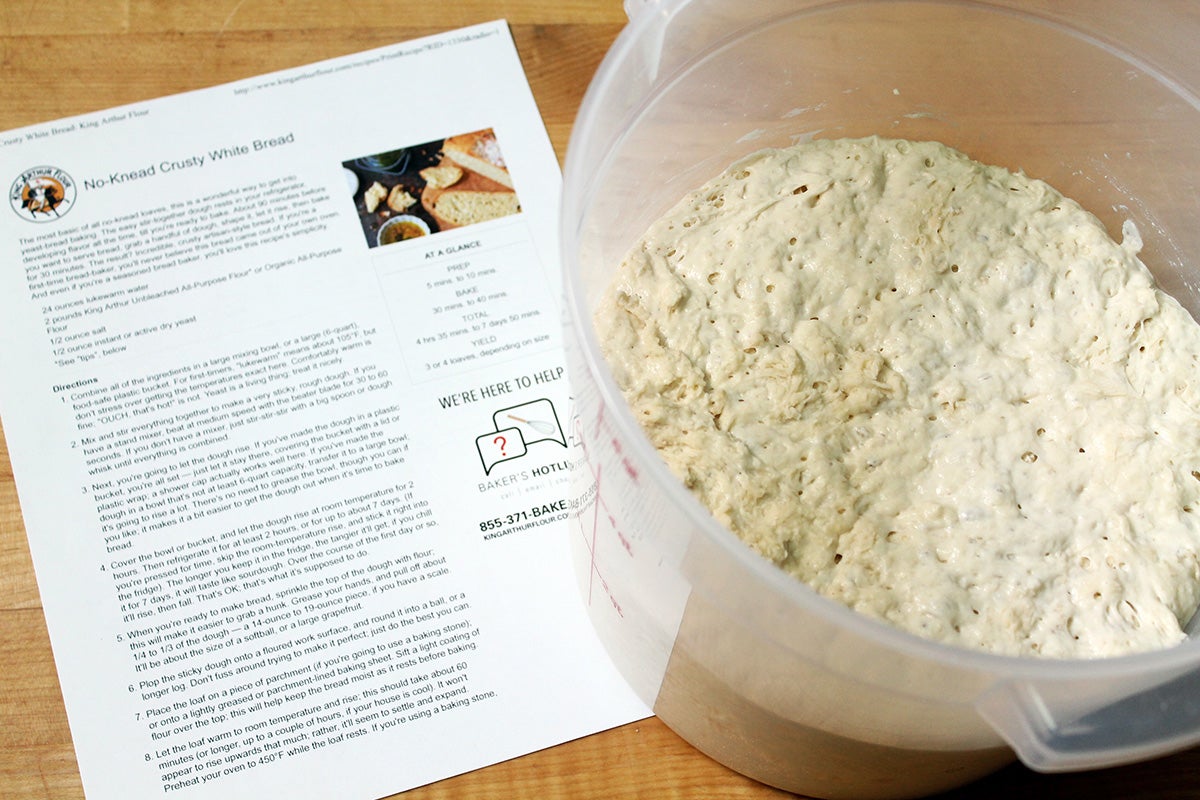
Prepare the recipe as written, which often includes a 24-hour (or longer) rest in the fridge for no-knead dough; be sure to plan ahead.
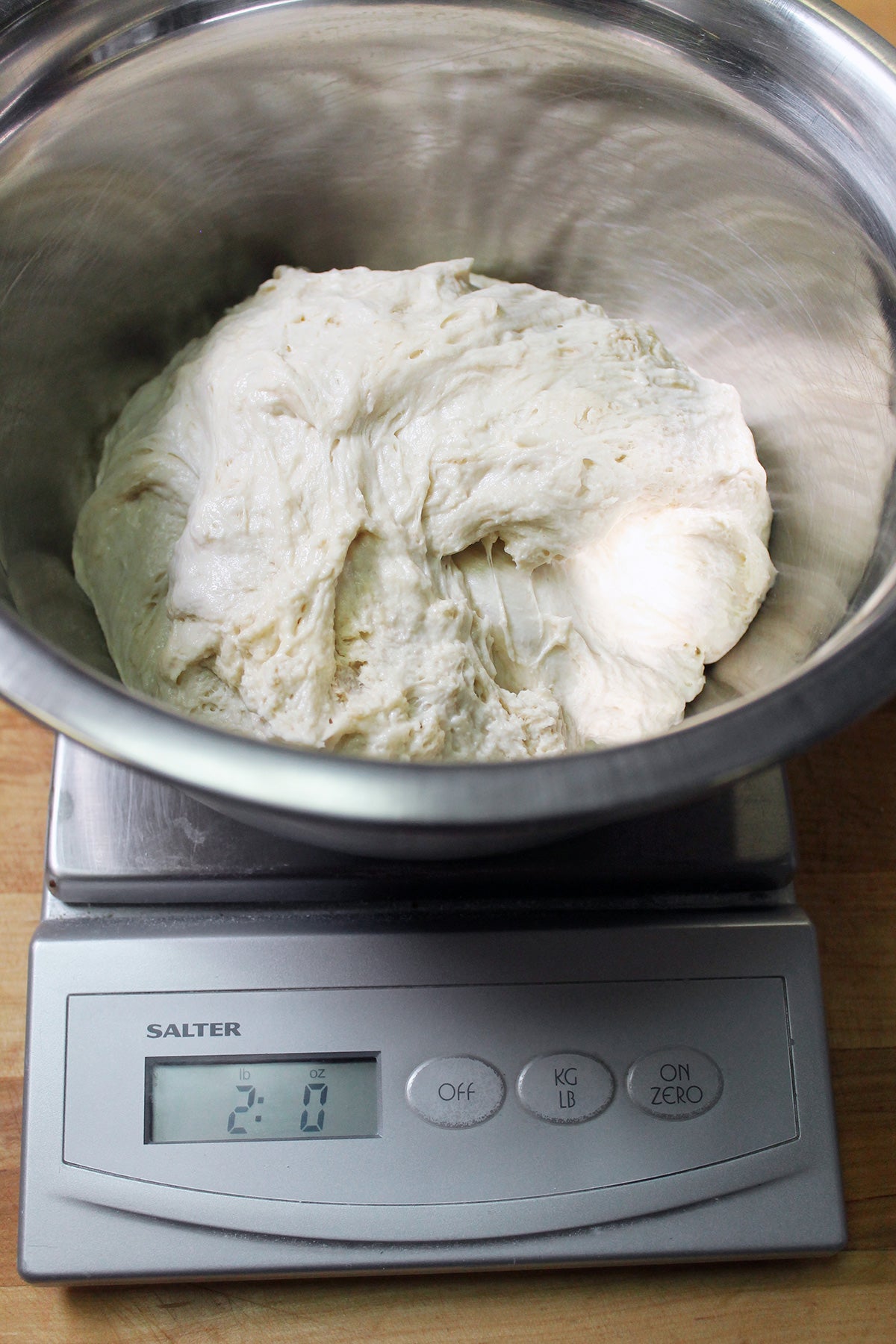
When you’re ready to bake, measure out a two-pound ball of dough. If you don’t have a scale, it should look like it will fill the base of the Bread and Potato Pot most of the way.
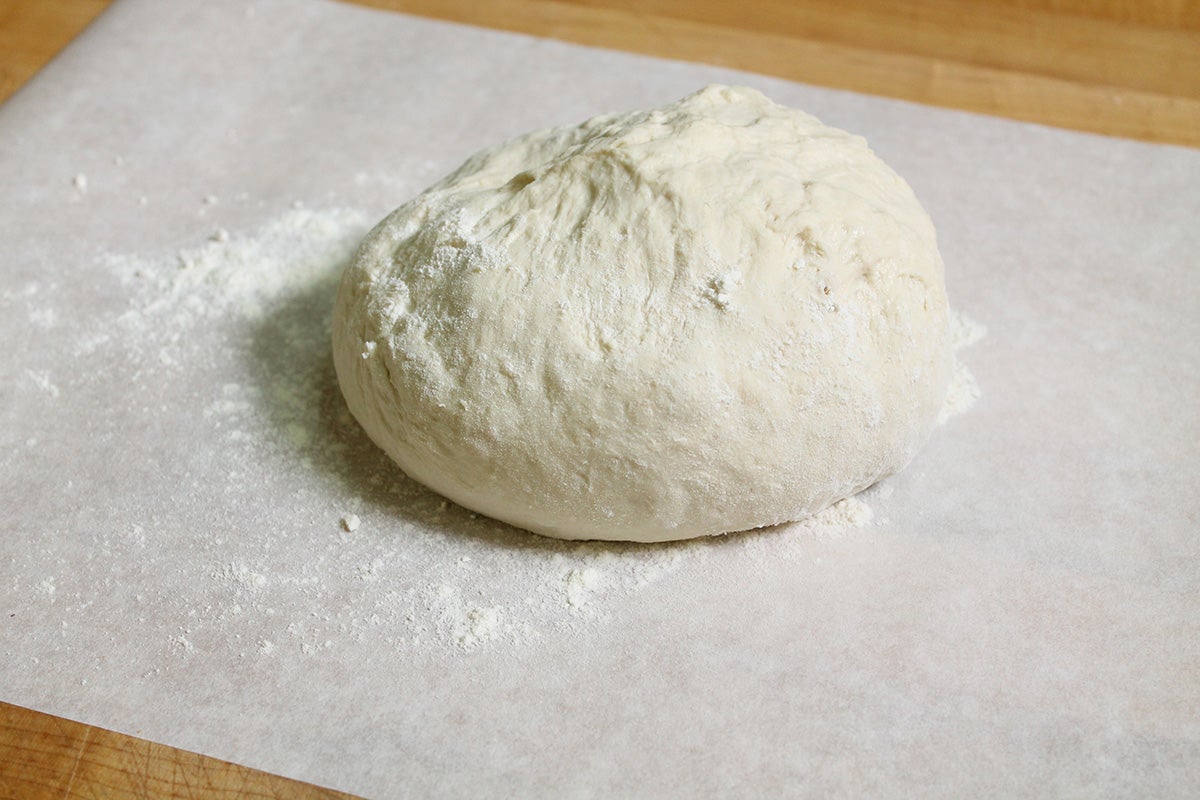
Shape the dough and let it rest on a floured kitchen towel or piece of parchment paper with the seam side up, covered, while it rises. (You can also use a brotform if you want to make some fancy rings on the surface of your loaf.)
To ensure you get a burst of steam when the dough is put inside the pot, it should be preheated empty for about 30 minutes. Start preheating your pot roughly 30 minutes before your rising dough is ready to bake.
Keep in mind the temperature of your kitchen will make a difference in how quickly the dough rises. The No-Knead Crusty White Bread dough can take anywhere from one to three hours to rise; in my cool Vermont kitchen, I usually let it rise for at least one hour before preheating the pot for 30 minutes, giving the dough a total of a 1 1/2 hours to rise.
When your dough looks like it will be ready in 30 minutes, put the Bread and Potato Pot (both the bottom and the lid) into the cold oven, and set it to 450°F (or the temperature your recipe calls for).
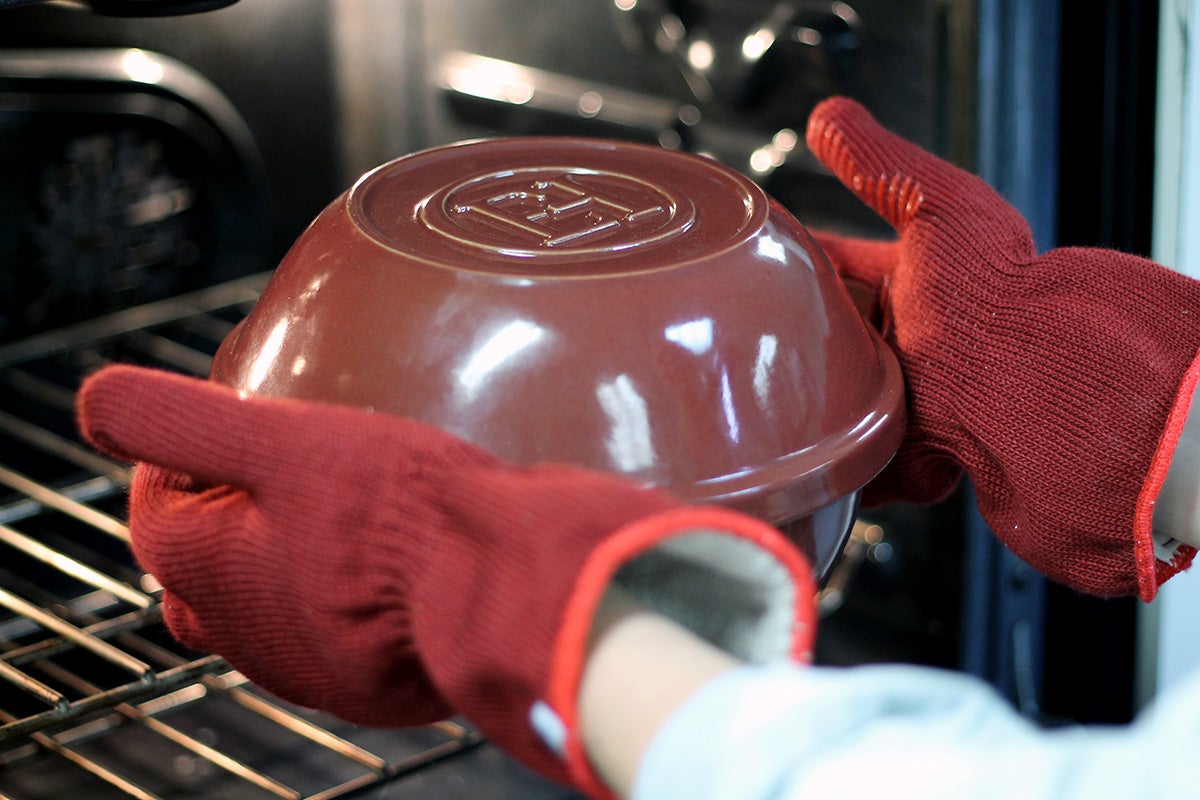
Half an hour later, the dough should be risen and the pot should be thoroughly preheated. Carefully remove the hot pot from the oven, taking care to place it on a neutral surface like a cooling rack, wooden board, or kitchen towel. (Avoid contact with anything cold, such as cold water or a cold surface; this may cause the pot to crack.)
Apply a gentle coating of vegetable oil-based non-stick spray and sprinkle in some semolina flour or cornmeal. (Be careful during this step — the pot may smoke slightly when prepared.)
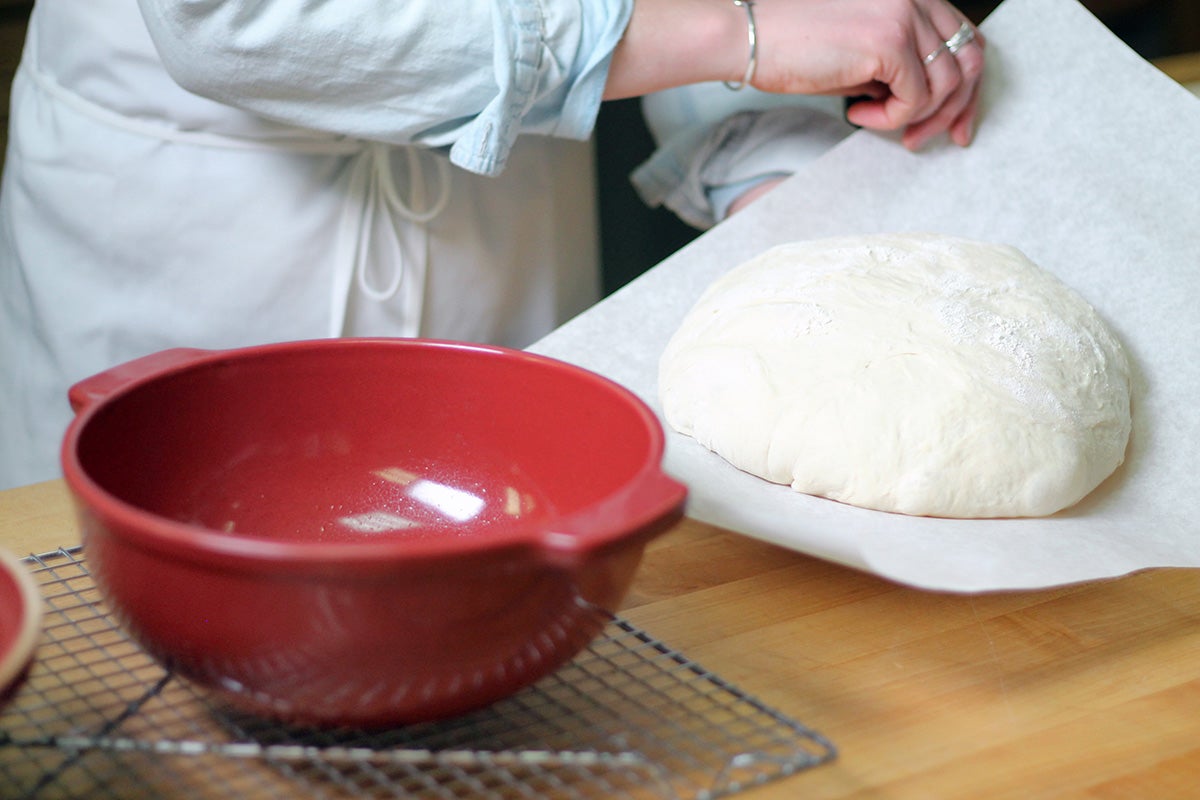
Slide your hand under the towel or piece of parchment paper and turn the dough over into the pot, seam side down. You can gently shake the pot from side to side to help the dough settle evenly in the bottom.
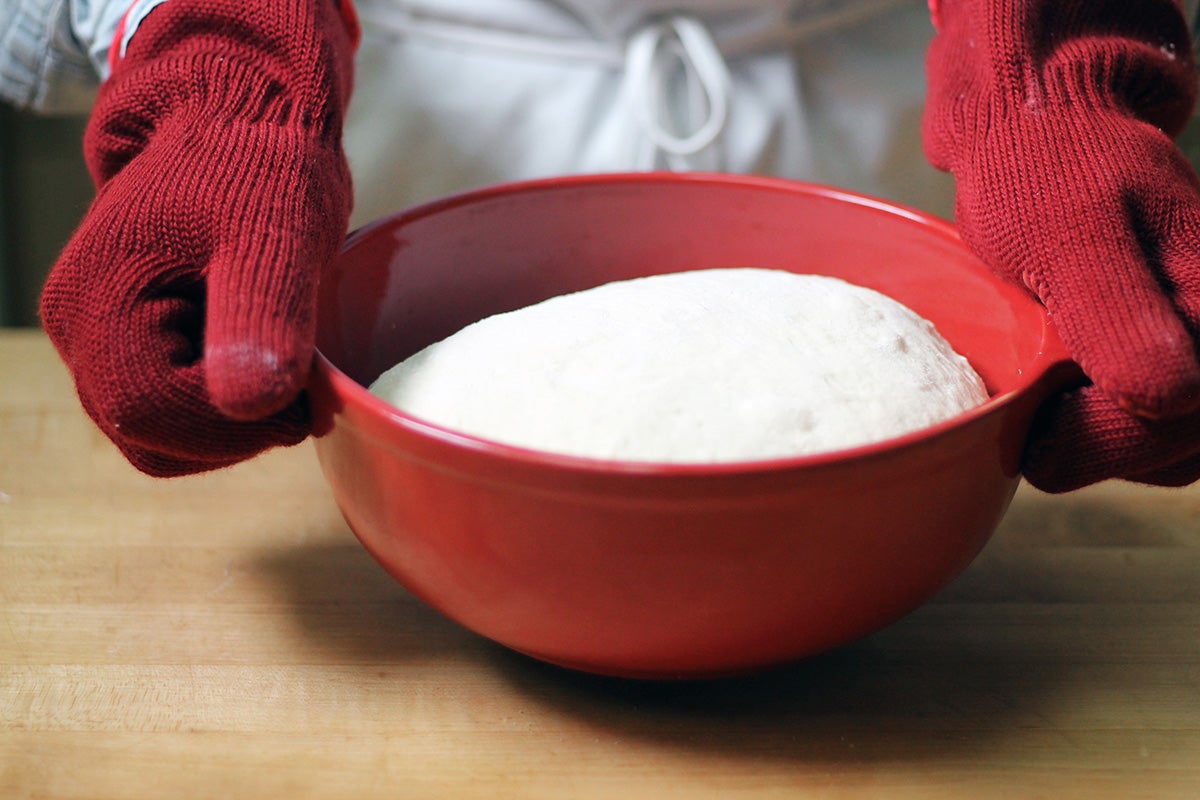
Don’t worry if your dough doesn’t look picture-perfect here; it will turn into a beautiful, golden loaf as it bakes.
Make a few slashes in the top of your loaf (a lame works well for this), and then put the lid on. Bake for 25 to 30 minutes; remove the lid and bake for another 5 to 10 minutes, until the loaf browns fully.
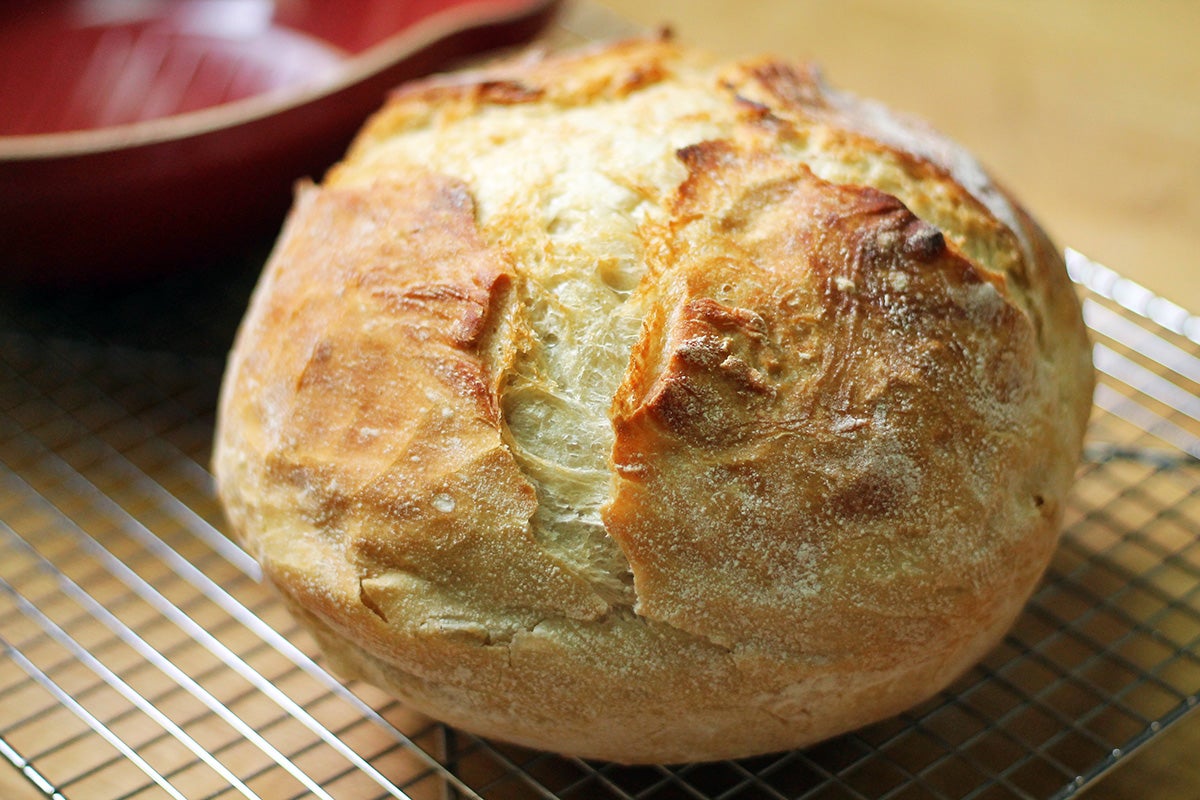
Remove the loaf from the oven and let it cool completely on a rack before slicing.
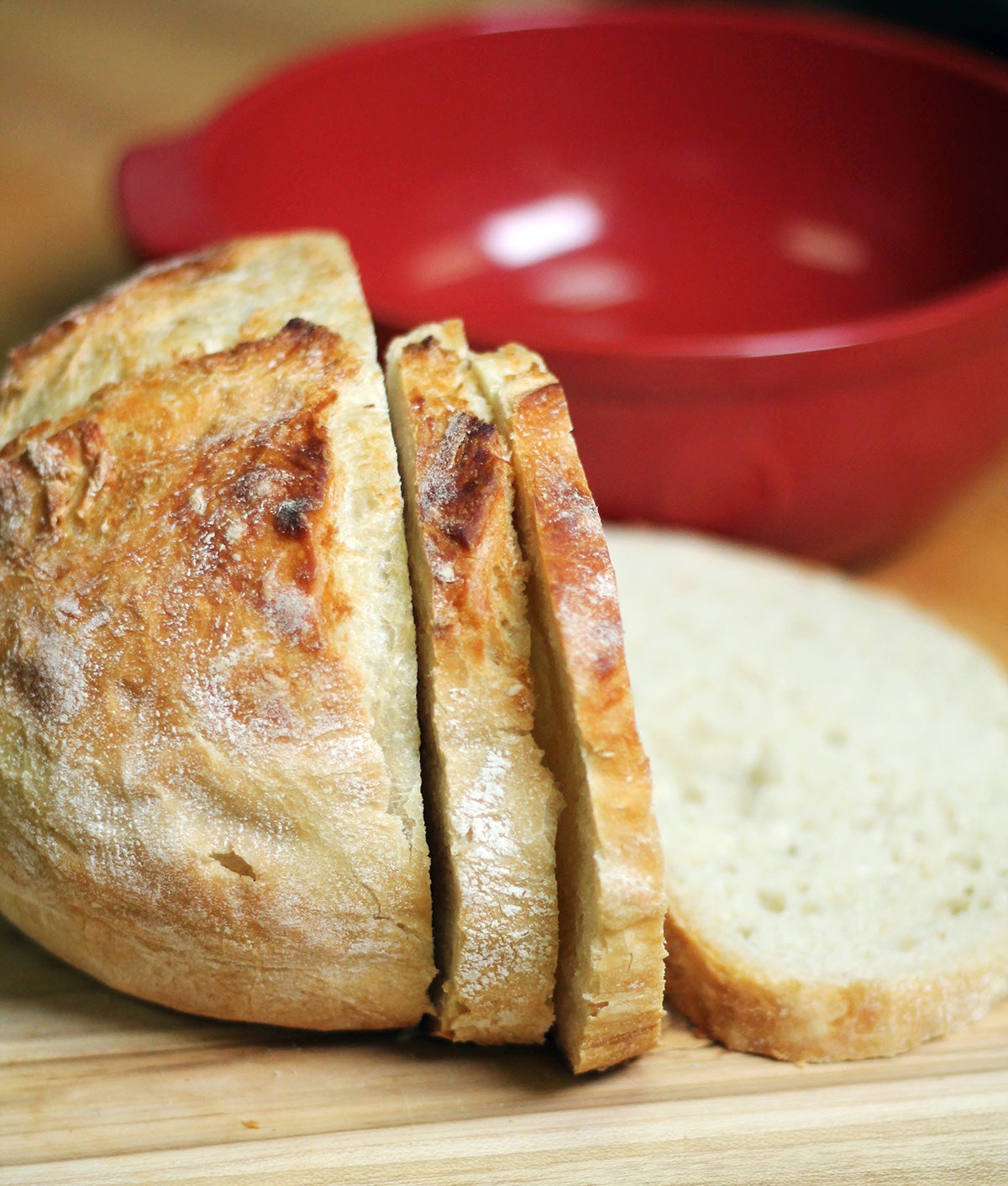
Beautiful crust? Check. Open crumb? Check. Yeasty flavor? Check.
I was stunned by the impressive looking loaf I pulled out of the oven the first time I used this method. I yelped with joy and declared it the best-looking loaf I had ever made! But then I wanted to find out, was it really the wonders of preheating the Bread and Potato Pot — or just this much-loved, no-knead recipe?
To see if there was any difference, I baked a second loaf (same recipe, same amount of dough, same length of time in the fridge) but baked it on a baking sheet instead of in the Bread and Potato Pot.
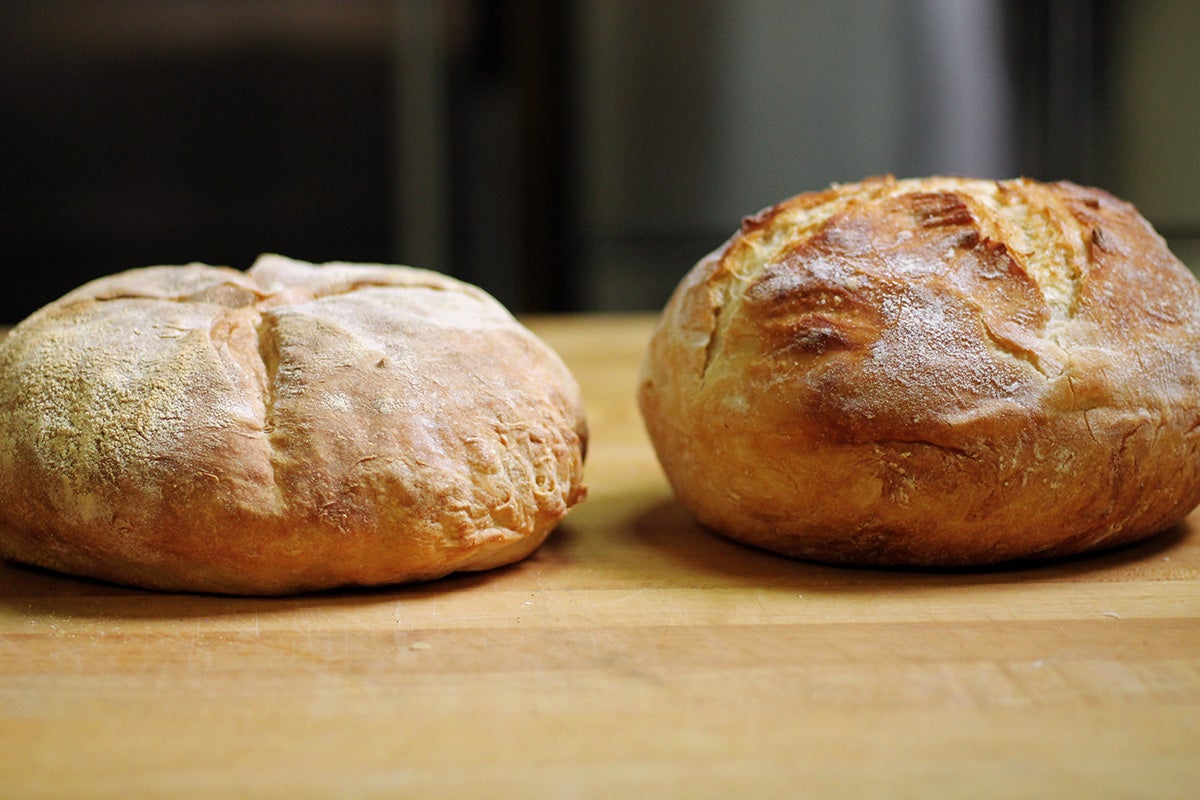
The side-by-side comparison shows that bread baking in a Dutch oven (and preheating it first) is the key to making an artisan-looking loaf. More steam is created inside the preheated Bread and Potato Pot than when water is poured into a pan in the bottom of the oven, one trick for making crusty bread. Plus, regular ovens vent, so it’s difficult to maintain a moist environment if you don't use a covered baker.
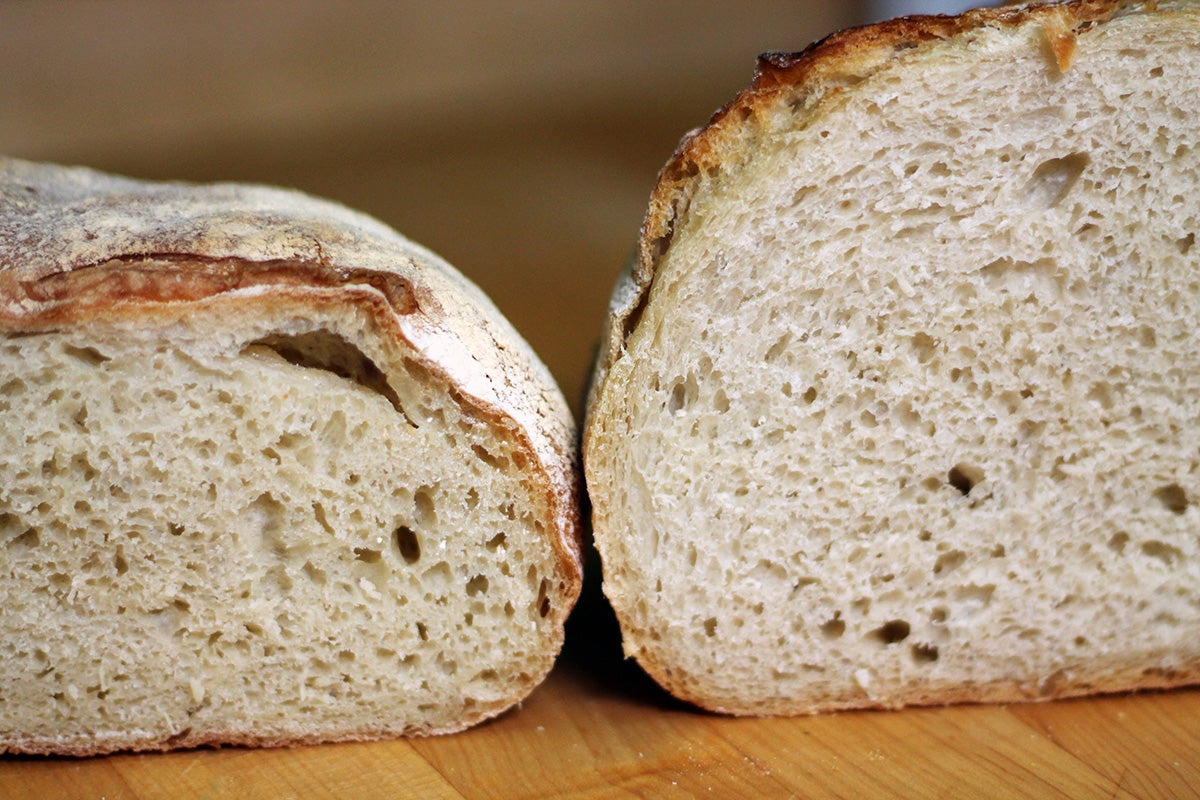
While the crumb was similar, the height difference and crust color of the bread baked in the Bread and Potato Pot made it a more appealing loaf.
A preheated Dutch oven captures a burst of steam, resulting in a perfectly baked loaf.
While the Bread and Potato Pot is perfectly suited to this preheating method, other pots in your repertoire may be able to produce similar results.
You can try using a 4- to 5-quart heavy covered pot, like a cast iron Dutch oven. Some Pyrex and ceramic Dutch ovens might also stand up to the task, but you’ll want to check the manufacturer's recommendation about preheating empty before giving it a try.
The wonders of this pot aren’t limited to No-Knead Crusty White Bread — you can try one of the delicious variations of this recipe if you’re looking to make bread that’s a little more exciting.
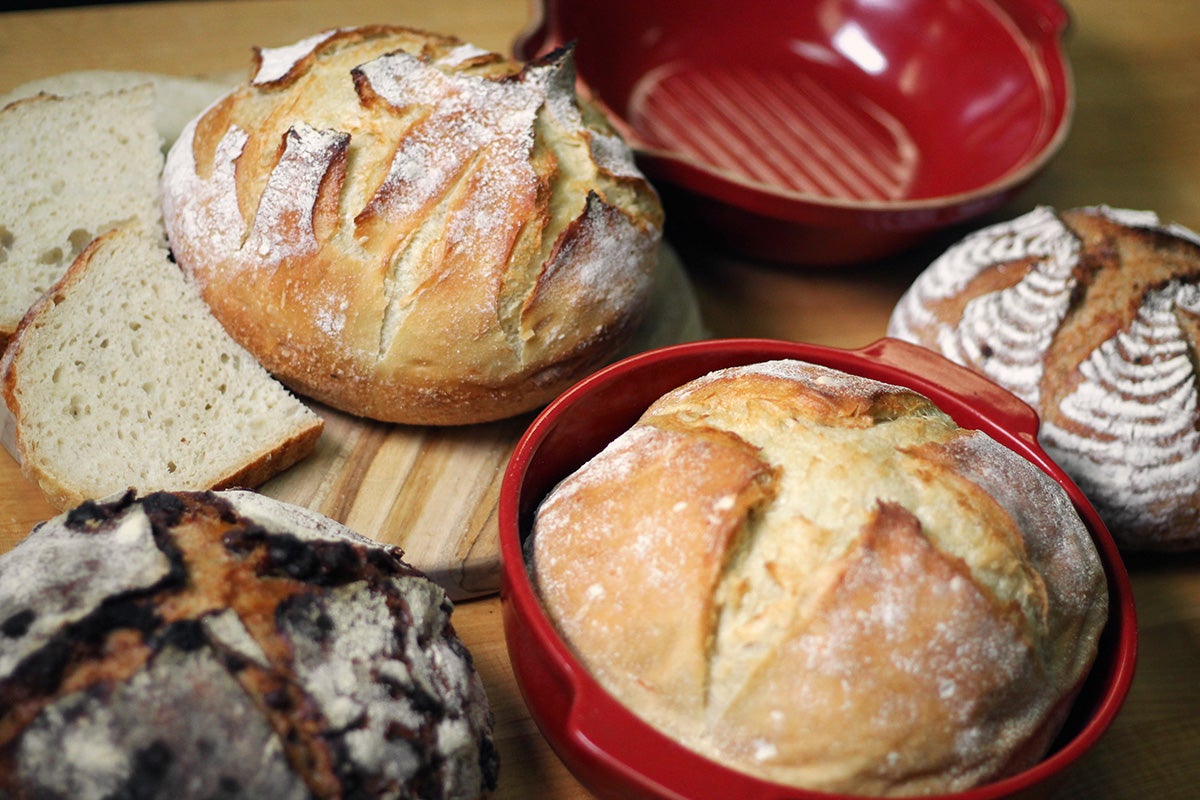
No-Knead Harvest Bread, No-Knead Crusty Whole Wheat Bread, and No-Knead Chocolate-Cherry Pecan Bread are also great choices when it comes to bread baking in your Dutch oven: the possibilities are endless when you use this simple preheating tip.
There’s so much to love about the Bread and Potato Pot — it can turn anyone into a bread baker. If you give this method a try, you'll say goodbye to store-bought bread in no time.
Share your experiences and best tips for bread baking in a Dutch oven in the comments, below.
Thanks to fellow employee-owner Seann Cram for taking the photos for this blog.
April 14, 2022 at 1:09pm
I have a Lodge 5 quart enameled Dutch oven and I’ve read that enameled Dutch ovens can not be preheated. How can I use this Dutch oven to bake sourdough bread? Thank you!
April 18, 2022 at 12:05pm
In reply to I have a Lodge 5 quart… by Robin K (not verified)
Hi Robin, if you don't think your Dutch oven is suitable for perheating empty, it's fine to put the pot/dough together into a preheated oven. When using this method, I would remove the lid after 25 minutes of baking. You also have the option to bake with a cold start. When letting your dough rise in your Dutch oven for the final rise, this is a situation where the dough is a little more likely to stick, so take extra precautions. I would recommend either greasing your pot well or lining the pot with sprayed parchment paper. If you crumple the paper up before spraying it with baking spray, this will help it conform to the pot more readily.
April 15, 2023 at 7:09pm
In reply to Hi Robin, if you don't think… by balpern
Hi
I just bought a Lodge Dutch oven and it says not to preheat on the stove but in the oven it’s fine. From the website:
We do not recommend preheating an empty piece of enameled cast iron on the stovetop as it could damage the enamel coating. Instead, make sure the cookware has water or oil inside it to distribute heat evenly, and be sure to start with low heat while the vessel is getting warmed up.
It is perfectly safe to preheat empty enameled cast iron in the oven since the heat will be more consistently distributed across the entire cooking vessel.
I wanted to mention this since I looked through the comments for the exact same question😊
April 11, 2022 at 7:27am
I have been happily baking bread in my dutch oven for several years. But as my husband no longer eats bread, I'm looking for information on making smaller loaves in a smaller dutch oven. Do you have any information on how a smaller volume dough will affect baking times? If not I guess I pull out my lab notebook and start experimenting!
Thanks!
April 11, 2022 at 2:35pm
In reply to I have been happily baking… by Corni Forster (not verified)
Hi Corni, when baking a smaller loaf in a smaller pot I would still bake at the same temperature and remove the lid at the same time, but you may find that the final baking time without the lid is shorter. Keep an eye on your bread and look for normal signs of doneness. A half-sized loaf won't necessarily bake in half the time, but baking time may be 5-10 minutes less. Try to make sure that the size of the dough lines up nicely with the pot, so the dough is encouraged to rise upward, particularly if you're working with a very wet dough. Another option to consider would be to continue baking your larger loaves and freeze half after baking. Bread freezes great, and it's always nice to have more baked bread in the freezer!
April 12, 2022 at 4:22pm
In reply to I have been happily baking… by Corni Forster (not verified)
I make smaller loaves all the time in the full size Dutch ovens. I use a small brötform or put a floured thin dish towel in a small round bowl for the final proof. The key for me is the size of the bowl, not of the baking pot. Once a nice surface forms on the loaf it tends to retain its shape. I’ve even made two small round loaves in an oval le Creuset pot with no spreading and touching.
March 22, 2022 at 11:54pm
What an informative article! This will be a fun new direction for me in bread baking. The bread and potato pot you recommend is too pricey for me, but you said cast iron could work, too, so I looked around and am considering the more affordable Overmont 2 in 1 Dutch Oven with Skillet Lid. It seems to be marketed primarily as a campfire stove, but there's a slew of reviewers who rave about it for baking bread and other types of home cooking. While it's decidedly less sleek than the pot you mention, and it sounds a bit cumbersome to handle (maybe easy for campfire cowboys, but probably not so for me), but it's making a lot of bread bakers very happy. Users say it does just fine preheating while empty in a blazing-hot oven without cracking (thanks for that important piece of advice). I should add that I'm becoming a big King Arthur Baking fan, what with all the useful info and great recipes on your site. Thanks so much!
March 25, 2022 at 4:37pm
In reply to What an informative article!… by Judy Lin (not verified)
Hi Judy, that pot should work just great for bread baking purpose!. Keep in mind, however, that at 5-quarts you may be able to make one large loaf rather than two smaller loaves, as some of our recipes recommend. You should be able to fit up to 2.75 lbs (1247g) of dough in that sized Dutch oven. When baking smaller loaves you may find that the dough spreads out a bit more in a larger pot, but if the dough is fairly firm and holds its shape well, it should still work well in your larger pot.
March 26, 2022 at 10:07am
In reply to What an informative article!… by Judy Lin (not verified)
I use a Staub dutch oven and it works beautifully! I put 2 strips of parchment paper with just a bit of flour or cornmeal on it before I put the dough into my preheated pot/lid. Makes removing the baked break so easy!
March 20, 2022 at 9:09am
When I bake a loaf in the Dutch oven the bottom of the loaf turns out almost impossible to slice. What could improve that?
Pagination